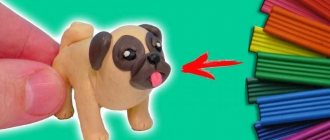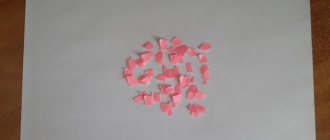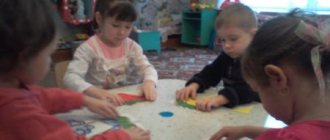Summary of GCD for modeling junior group Insects
Summary of educational activities
Cognition + sculpting
in the younger group
on the topic: “Insects in the clearing.”
Subject
: “Insects in the clearing”
Tasks:
— developing:
Continue to develop children's interest in understanding the world around them (insects live only in the summer), imagination, thinking, speech, and auditory perception.
- raising:
cultivate a desire to engage.
— educational
: expand children's understanding of insects living around us: beetle, butterfly, ladybug, caterpillar. Learn to name the distinctive features of appearance: the caterpillar has a long body and cannot fly; the beetle has antennae; The butterfly has beautiful wings. Continue to teach children the ability to assemble pictures from several parts.
Methods and techniques:
gaming – creating a gaming situation; verbal - conversation, question - answer, literary word; practical - performing actions with objects, demonstrating modeling techniques, performing a type of movement - walking on tiptoes.
Visual teaching aids:
Demo -
easel, illustrations of insects, illustrations of meadows (winter and summer), chairs.
Dispensing –
tray, pictures from 4 parts, insects according to the number of children, boards, plasticine.
GCD structure
: 1.hour introductory – 5 min; 2.h. main – 12 min; 3. final – 3 min.
Progress:
Children enter the group, I teach the children:
Me: “Guys, I suggest you take a walk to the clearing. In order not to scare off the insects, let's approach them on our tiptoes. Let’s say the sound “tssssss” to each other (we close our mouths with a finger to our lips, we turn our heads towards each other). Walking on tiptoe with the children, I pronounce the words:
In a forest clearing
In a clearing in the forest, a beetle and a caterpillar met. A butterfly also flew to them. It was a sunny day. And all three of us were friends
You appear in the clearing
And show yourself to the guys.
We go to the easels on which insects are displayed (beetle, butterfly, caterpillar, lady's box).
-Who is this, guys?
Children list insects.
- Guys, what does the beetle have? (paws, antennae...). Well done, right.
- The butterfly has (wings, antennae...). Fine. The caterpillar has (head...). Tell me which insect cannot fly (caterpillar). How does she move? (crawls). Guys, tell me what shape is God's head (round)? Colors? (black). Torso? (red)
I suggest going to the tables on which parts of the pictures lie.
Did. A game
“
Assemble a picture.” (
from 4 parts, assemble a whole one - a beetle, a caterpillar, a ladybug, a butterfly). Children list what they have collected.
Then I suggest you go to the carpet; on the carpet there is a large sheet of paper with a winter and summer landscape drawn on it.
Did. Game “What time of year do insects live?”
— At what time of year do insects appear? (In spring, when it gets warmer and green grass appears). That's right, well done. Here are the insects, I propose to take one insect at a time and put it in the clearing that depicts the time of year in which the insects live. Think and decide.
Children each take an insect and place it on the summer landscape.
- Tell me why you put it in the summer meadow? Children's answers:
- Because in winter they will freeze. It's cold in winter, warm in summer, etc. In winter, insects hide in the bark of trees to wait out the winter.
- That's right, insect guys can only live in the summer, and in the winter they will freeze from the cold.
Please note that we assembled a picture from 4 parts and among them there was a ladybug, but it is not in the clearing. Maybe he hasn’t woken up from the warm spring sun yet. A buzzing sound is heard. (I turn on the buzzing sound).
- So the beetle is looking for its girlfriend. I propose to help the beetle and make a ladybug so that he can have many friends.
Children go to their desks. There are boards and pieces of red and black plasticine on the tables. I show sculpting techniques and talk through my actions.
The children get to work. I help those who are in difficulty. At the end, the children also take their work to the green meadow.
“I’ll put my ladybug in a green clearing, there’s a beetle that’s been waiting for it for a long time.” (I take the ladybug to the table where the clearing is depicted). (from what colors of plasticine did we sculpt the ladybug, what shape is the head, body, what does the ladybug have on its back?
I analyze the lesson:
-Where did we go? Who were you considering? What time do insects live? etc.
https://nsportal.ru/detskiy-sad/applikatsiya-lepka/2016/11/06/konspekt-obrazovatelnoy-deyatelnosti-poznanie-lepka-vo
Summary of OOD on modeling for children of the junior group of the preschool educational institution "May Bug"
Summary of organized educational activities for children of the junior group “Chafer Bug”
Goal: continue to introduce children to different insects.
Program objectives: Educational: - introduce children to the “chafer bug”, consider what parts it consists of (head, torso, wings, paws, mustache, eyes); - consolidate sculpting techniques by pinching from a whole piece of plasticine and by pressing down the parts to connect; — consolidate the pronunciation of the sound [Zh]; — fix the score within five;
Developmental: - development of fine motor skills of the hands; - speech development; — development of the articulatory apparatus; - development of speech breathing;
Educational: - cultivate interest and curiosity for living nature.
Methods and techniques: verbal, game, visual, practical.
Material: picture - cockchafer, brown or burgundy, green and black plasticine (for eyes and mustache); toy May beetle or simple beetle, sound recording - buzzing sound.
Preliminary work: looking at insects while walking.
Progress: The teacher draws the children’s attention to the sound that is heard in their group. A recording of buzzing sounds. Educator: - Children, listen, I think I hear some sound. What could it be? Children: - It's buzzing, maybe it's a beetle.
The teacher takes out a toy beetle from under the table. The sound stops. Educator: - Hello, beetle - beetle, reddish tank. Was it you who was buzzing around us and scared all the guys? Children look at a beetle.
Also an interesting lesson in sculpting in ml. preschool educational institution group: Summary of a lesson on artistic creativity (modeling) in the second junior group of the kindergarten “Ladder for the little squirrel”
Educator: - Guys, in May a lot of insects appear, they come to life after hibernation. These are the beetles that are called May beetles. Let's look at the picture, tell me what the beetle has? Children: - Torso, wings, mustache, eyes, head, paws.
Educator: - What color is it? Children: - Red, brown.
Educator: - How many paws does a beetle have on each side? Children count. Children: - Three paws on each side.
The teacher draws the children's attention to special fluffy mustaches with tassels at the ends. Educator: - How many mustaches does the cockchafer have? Children: - A pair of mustaches.
Educator: - That's right, well done. Let's buzz like bugs. Articulation gymnastics “Beetles”. Children pronounce zhu - zhu - zhu by stretching their lips forward in a tube.
Educator: - Suddenly a light breeze blew on a spring flower. Breathing exercise, children blow on their palm.
Educator: - Children, and also beetles, can fly from one plant to another. Let's play the game "Bugs for a Walk." Outdoor game “Beetles for a walk.” The teacher divides the territory on the carpet with a jump rope or ribbon, crawl on one side, and fly on the other side. At the command of an adult - “On the flower”, children begin to crawl on all fours; at the signal - “Let’s fly”, children jump over the tape and “fly” on the other side of the carpet.
Educator: - Guys, it’s a pity that the cockchafer is not so often found in the city. Or maybe we’ll make our own cockchafers from plasticine? Children: - Yes!
The children sit at the tables. Perform finger gymnastics “Beetles”. Moving your fingers across the table “like bugs.” They knead the plasticine, make a body, and use the technique of pinching the head and pressing to attach the paws, whiskers, and eyes. Draw a line of wings on the back in a stack. The teacher helps by individually showing modeling techniques.
Educator: - Well done! You made some excellent cockchafers.
Result: Children look at their plasticine cockchafers and play out any plot.
Title: Abstract of educational activities on modeling for children of the junior group of the preschool educational institution "May Bug" Nomination: Kindergarten, Lesson notes, GCD, modeling, applique, junior group Author: Bolkunova Valentina Vladimirovna Position: teacher Place of work: MBDOU No. 81 "Kindergarten" Location : Kemerovo, Kemerovo region
Date modified: 05/13/2016 Date of publication: 05/13/2016




